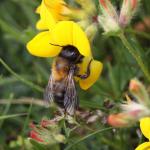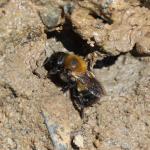Osmia fuciformis LATREILLE 1811; Osmia chrysomelina PANZER 18112; Osmia atricapilla CURTIS 1828; Osmia pyrenaica LEPELETIER 1841
Of the 24 species of endangered bees listed in the British Red Data Book (Shirt, 1987), four have only been recorded in recent years from a single site. One of these is Osmia xanthomelana, the largest and perhaps the most attractive of the ten species of British Osmia.
In the past there was a widespread distribution of this species in Britain, from the south coast northwards to Tyneside. It has been recorded from about 28 widely scattered localities (Else, 1994b). Throughout this century there has been a contraction of this range southwards, so that currently the species is on the verge of extinction. Many of these older records have not made it into the BWARS database and so the the map here mostly indicates it's current very limited distribution. The mapped data for the Isle of Wight represent the known nesting location and a single specimen from the south side of Sandown Bay. The population there in most years is estimated to consist of a few tens of individuals, though daily totals of individuals seen are considerably less (Else, 1994b). Some apparently ideal sites in north Wales for the species were investigated in 1994 and 1995 by C Clee, but unfortunately without success. The cause of this considerable decline is unknown but may possibly be a combination of loss of suitable habitat and climatic changes. The bee is also rare elsewhere in Europe.
Listed as Endangered (RDB1) in Shirt (1987) and Falk (1991).
In its remaining British site the bee frequents a short section of sandstone and chalk cliffs, and an adjacent landslip. Most specimens have been observed at the base of these, though some females were also seen visiting horseshoe vetch at the top of the cliff (pers. obs.). Freshwater seepages from the cliff are necessary as a source for nest-building materials.
Single-brooded; May to mid-June (exceptionally, March, April and mid-July).
A nest generally consists of five or six pitcher-shaped cells, either standing as a cluster, with their bases inserted into the soil (Waterhouse, 1844; as Osmia atricapilla), or arranged within a burrow (Mortimer, 1905). The cells are built with mud mixed with grit or small stones; each is sealed with a flat lid of the same materials.
On the Isle of Wight, the bee has been observed visiting only bird's-foot-trefoil (Lotus corniculatus) and horseshoe vetch (Hippocrepis comosa) flowers. There is also a record of the species visiting ground-ivy (Glechoma hederacea) flowers from near Bristol (Smith, 1876).
Sapygidae are known cleptoparasites of Osmia species, and in north Wales Mortimer (1905) observed many females of Sapyga quinquepunctata inspecting open cells of O. xanthomelana.
Profile written: 1998
Proofed: January 2012
Updated 2024



